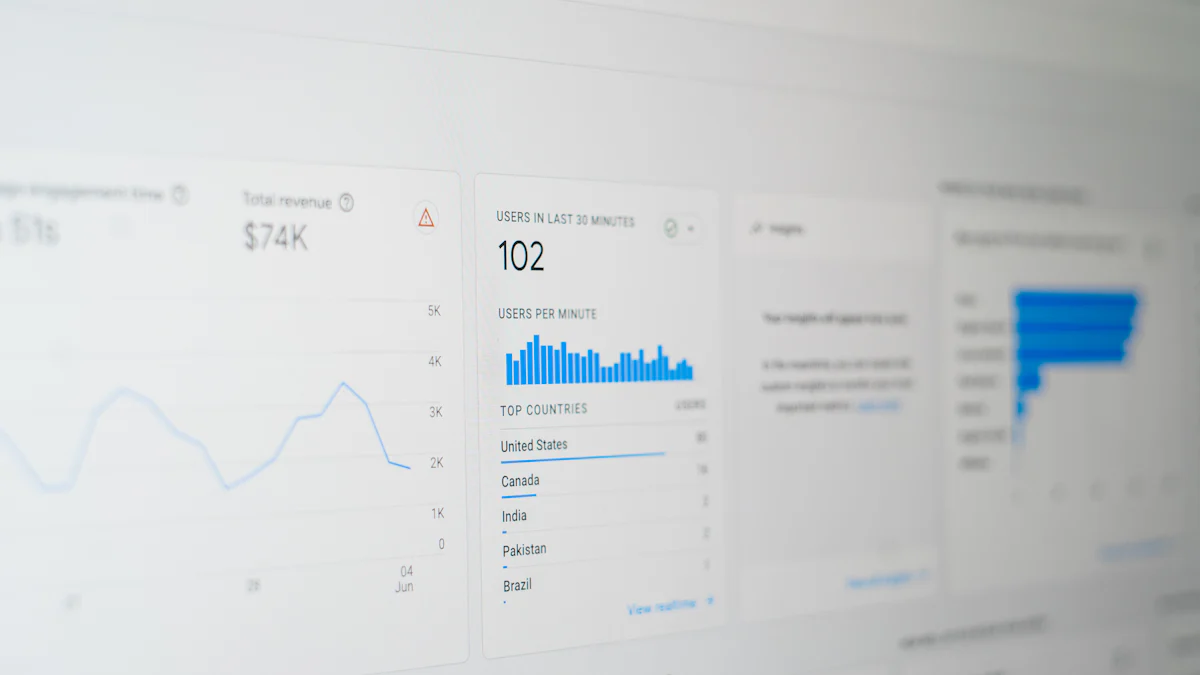Unlocking the Benefits of Content Marketing Infographics

In today's fast-paced digital world, visual content plays a crucial role in capturing your audience's attention. Did you know that 91% of consumers prefer visual content over written text? This preference highlights the power of visuals in modern marketing strategies. Among these, content marketing infographics stand out as a particularly effective tool. They simplify complex information, making it more digestible and engaging. Infographics are not just eye-catching; they are also 40 times more likely to be shared on social media. Platforms like QuickCreator can help you design these impactful visuals, enhancing your marketing efforts significantly.
Benefits of Using Content Marketing Infographics

Enhanced Engagement
Capturing Audience Attention
You know how hard it can be to grab someone's attention these days. With so much content out there, standing out is crucial. Content marketing infographics do just that. They transform complex information into visually appealing graphics that catch the eye. According to studies, infographics are 30 times more likely to be read than plain text. This means your audience is more likely to stop scrolling and start engaging with your content.
Increasing Social Media Shares
Infographics are liked and shared three times more on social media than any other type of content. This increased sharing boosts your reach and visibility, helping your message spread far and wide. Platforms like QuickCreator can assist you in designing these shareable visuals, making your content marketing strategy even more effective.
Improved Information Retention
Simplifying Complex Data
Ever tried explaining a complicated concept with just words? It can be tough. Infographics simplify complex data, breaking it down into easy-to-understand visuals. This makes it easier for your audience to grasp the information quickly. By using content marketing infographics, you ensure that your message is clear and concise, which helps your audience retain the information better.
Making Content Memorable
Memorability is key in marketing. You want your audience to remember your message long after they've seen it. Infographics make content memorable by combining visuals with concise text. This combination helps reinforce the information in the viewer's mind. When your audience remembers your content, they're more likely to engage with your brand in the future.
Boosted SEO Performance
Increasing Backlinks
Infographics not only engage your audience but also improve your SEO performance. They attract backlinks from other websites, which is crucial for SEO. When other sites link to your infographic, it signals to search engines that your content is valuable and relevant. This can boost your site's authority and improve its ranking in search results.
Enhancing On-page Time
Keeping visitors on your page longer is another SEO benefit of infographics. When people find your content engaging, they spend more time on your site. This increased on-page time signals to search engines that your content is valuable, which can improve your search rankings. By incorporating content marketing infographics into your strategy, you enhance both user engagement and SEO performance.
Actionable Do's and Don'ts for Creating Content Marketing Infographics
Creating a content marketing infographic can be a game-changer for your brand. But like any tool, using it effectively requires some know-how. Let's dive into some actionable do's and don'ts to ensure your infographics hit the mark.
Do's
Focus on Quality Design
Quality design is crucial. You want your infographic to stand out and grab attention. A well-designed infographic not only looks professional but also enhances the message you're trying to convey. Use colors that complement each other and fonts that are easy to read. Remember, simplicity is key. Experts in infographics design suggest focusing on clarity and visual appeal to captivate your audience. Platforms like QuickCreator offer templates and tools to help you achieve a polished look without needing a design degree.
Use Accurate Data
Accuracy builds trust. When you include data in your infographic, make sure it's correct and up-to-date. Double-check your sources and cite them if necessary. This not only adds credibility to your content but also reassures your audience that they can rely on the information you're providing. Accurate data paired with a compelling design makes your content marketing infographic a powerful tool for engagement.
Don'ts
Avoid Overloading with Information
Less is more. It's tempting to cram as much information as possible into your infographic, but this can overwhelm your audience. Stick to the essential points and present them clearly. Break down complex ideas into digestible chunks. This approach not only makes your infographic more readable but also ensures your audience retains the key messages. Remember, the goal is to inform, not to confuse.
Steer Clear of Poor Design Choices
Poor design can ruin even the best content. Avoid using clashing colors, hard-to-read fonts, or cluttered layouts. These choices can distract from your message and turn off your audience. Instead, aim for a clean and organized design. Use whitespace effectively to give your content room to breathe. By steering clear of these pitfalls, you ensure your infographic remains engaging and effective.
By following these do's and don'ts, you can create content marketing infographics that not only look great but also deliver your message effectively. Whether you're using QuickCreator or another tool, keep these tips in mind to maximize the impact of your visual content.
Best Practices for Sharing Content Marketing Infographics

Sharing your content marketing infographic effectively can significantly boost its reach and impact. Let's explore some best practices to ensure your infographics get the attention they deserve.
Choosing the Right Platforms
Selecting the right platforms is crucial for maximizing the visibility of your infographics. Different platforms cater to different audiences, so it's essential to tailor your sharing strategy accordingly.
Social Media Channels
Social media is a powerhouse for sharing visual content. Infographics are highly shareable on platforms like Facebook, Instagram, and Twitter. These channels thrive on visual content, making them ideal for infographics. You can engage your audience by posting infographics that are relevant and timely. Encourage sharing by adding social sharing buttons and crafting engaging captions. Remember, infographics are 40 times more likely to be shared than text-based content, so leverage this advantage to expand your reach.
Email Marketing
Email marketing remains a potent tool for reaching your audience directly. Including infographics in your email campaigns can enhance engagement. Visual content breaks up text and makes emails more appealing. You can use infographics to summarize key points or present data visually. This approach not only captures attention but also increases the likelihood of your email being read and shared. Ensure your emails are mobile-friendly, as many users access emails on their phones.
Optimizing for SEO
Optimizing your infographics for search engines can drive organic traffic to your site. By following a few simple steps, you can enhance your infographic's visibility in search results.
Using Alt Text
Alt text is essential for SEO and accessibility. It describes the content of your infographic to search engines and users who rely on screen readers. When writing alt text, be concise and descriptive. Include relevant keywords naturally to improve search engine rankings. For example, if your infographic is about "content marketing infographic strategies," use this phrase in your alt text. This practice helps search engines understand your content and improves your site's visibility.
Incorporating Keywords
Keywords play a vital role in SEO. Incorporate relevant keywords into your infographic's title, description, and file name. This strategy helps search engines index your content accurately. Tools like QuickCreator can assist in designing infographics with SEO in mind. By embedding keywords naturally, you increase the chances of your infographic appearing in search results. This approach not only boosts visibility but also attracts targeted traffic to your site.
By choosing the right platforms and optimizing for SEO, you can maximize the impact of your content marketing infographic. Whether you're using social media or email marketing, these best practices will help you reach a broader audience and achieve your marketing goals.
Takeaways and Next Steps
As you wrap up your journey into the world of content marketing infographics, it's essential to reflect on the key benefits and how you can implement these insights into your strategy.
Recap of Key Benefits
Engagement and Retention
Infographics have proven to be a game-changer in capturing and retaining audience attention. They transform complex information into visually appealing graphics, making it easier for your audience to digest and remember. According to a survey, almost 41% of marketers believe infographics and illustrations are the most effective tools for achieving their marketing goals. By using infographics, you not only engage your audience but also ensure they retain the information longer.
SEO Advantages
Infographics also offer significant SEO benefits. They attract backlinks, which are crucial for improving your site's authority and search engine ranking. Additionally, infographics increase on-page time, signaling to search engines that your content is valuable. This dual advantage of engagement and SEO makes infographics an indispensable part of any content marketing strategy.
Implementing Infographics in Your Strategy
Setting Clear Goals
Before diving into creating infographics, set clear goals for what you want to achieve. Are you looking to increase brand awareness, drive traffic to your website, or educate your audience? Defining your objectives will guide the design and content of your infographics. Platforms like QuickCreator can help you align your design with your goals, ensuring your infographics are both visually appealing and strategically effective.
Measuring Success
Once your infographics are live, it's crucial to measure their success. Track metrics such as social media shares, website traffic, and engagement rates to evaluate their impact. Use these insights to refine your strategy and improve future infographics. Remember, the goal is continuous improvement. By regularly assessing your infographics' performance, you can ensure they remain a powerful tool in your content marketing arsenal.
Incorporating content marketing infographics into your strategy can unlock numerous benefits, from enhanced engagement to improved SEO performance. By setting clear goals and measuring success, you can maximize their impact and drive your marketing efforts forward.
Infographics have transformed content marketing by making complex information accessible and engaging. They capture attention and enhance retention, which boosts your brand's credibility. Imagine using a content marketing infographic in your presentations, just like the company's sales team did. It reinforces your expertise and leaves a lasting impression. You should integrate infographics into your strategy. Tools like QuickCreator make it easy to design impactful visuals. Start creating infographics today and watch your marketing efforts soar. Your audience will thank you for it!
See Also
Revealing Tomorrow: B2B Content Marketing Trends for 2024
Boosting Healthcare Content Marketing with 5 Proven Steps
The Definitive Manual for Achieving SaaS Content Marketing Success
Mastery in Crafting a Content Marketing Strategist Career in 2024
Perfecting SEO: 5 Complimentary Tools for Content Writing Triumph

